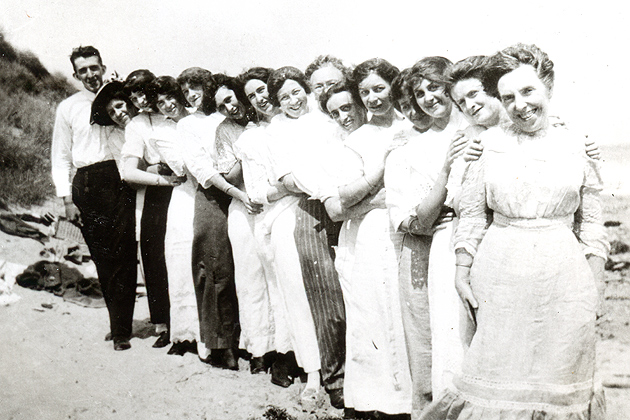

In the late 19th and early 20th centuries, Connecticut was known as an industrial state that was home to dozens of manufacturing businesses that produced textiles, brass, tools, and machinery. These businesses were located in various parts of the state, usually in large cities such as Hartford and Waterbury, but also in less populated areas such as Glastonbury, Bethel, and Norwich.
Companies like Cheney Brothers Silk Manufacturing of Manchester, American Brass of Waterbury, Thermos of Norwich, and New Britain Machine Co. of New Britain produced products for their customers made by workers who also enjoyed company-sponsored activities such as sports teams, picnics, social outings, and amateur nights.

A new photo exhibition at UConn’s Thomas J. Dodd Research Center titled “Workers at Play: Baseball Leagues, Basketball Competitions, and Company Picnics,” drawn from the Connecticut Business Collections in the Center’s Archives & Special Collections section, provides a look back at a part of the lives of workers during that time. The exhibit opens July 9 and continues through Oct. 19 in the Dodd Center Gallery.
“The collection allowed us to get a better sense of the community workers were able to enjoy 75 or 100 years ago, something I don’t think we have now that we have so many other ways to spend our leisure time,” says Laura Katz Smith, curator of the Connecticut Business Collections, which includes records and internal documents such as employee newspapers from 70 now-defunct state businesses. “When I put the exhibit together, I wanted there to be nostalgia for these kinds of activities. It must have been nice to have a sense of community with co-workers who were also teammates.”

Smith says many of the photos in the exhibition originally were published in newspapers, newsletters, or magazines that devoted much of their space to coverage of a company’s sports teams, including those for baseball, basketball, rifle clubs, and track teams. They also depicted employees performing in variety shows, enjoying picnics, and caroling at Christmas. The photos cover a time period from the 1890s to the 1980s.
“It’s thought by historians that companies wanted to engender employee loyalty and cut down on union activity,” Smith says about the proliferation of activities sponsored by companies long ago. “They also thought it improved productivity and that employees might find athletic skills they didn’t know they had. Today most company-sponsored programs are wellness programs to cut down on health care costs, not devoted to recreation.”

Documents in the archive indicate that many businesses gave workers time off to travel as members of the company’s sports team. In the 1920s, for example, most regional offices of the Southern New England Telephone Company had their own basketball team and would travel around the state playing other SNET teams and against teams from other businesses participating in organized industrial basketball leagues, Smith says.
The exhibition also includes photos of employees, both men and women, at picnics competing in three-legged sack races, tugs of war, baseball games and, in at least one event, women throwing a rolling pin. Among some of the photos in the exhibit:
- Employees of the Wauregan-Quinebaug Company, a textile mill in eastern Connecticut, in a park with a man holding a baseball bat, another drinking beer, and others with musical instruments.
- Men from Hartford Electric Light Co., sometime in the 1950s, dressed in ties and holding cigarettes on the lanes of a duckpin bowling alley.
- Female telephone operators from the SNET Norwich office at a beach outing in 1913 dressed in white dresses, stockings, and shoes.
- Families of workers at the Thermos Co. in Norwich at Christmas in 1954 standing in front of the Stanley Warner Palace Theater to see the film, “The Vanishing Prairie.”
- Various team photos from SNET including a baseball team in Waterbury 1909, women’s track in 1927, and a women’s basketball team in 1926 wearing high-top laced sneakers, knee socks, and V-neck shirts with the Bell Telephone logo with SNET inside.
Smith says the business records and documents in the Archives & Special Collections collection yields much more than simple nostalgic photos.

“When we collect company records, we think about how the company represents an industry important to Connecticut history, when Connecticut was an industrial powerhouse,” says Smith. “They can be used as a historical resource to tell us about life for workers of that time. For example, people do studies on hairstyles and how women would dress for work.”
Much of the research for the exhibition was done by Kyle Lynes, a librarian at Three Rivers Community College, who volunteered at the Thomas J. Dodd Research Center to get experience working with archival collections. She also helped prepare the exhibit, which Smith says will travel to UConn’s regional campuses and other venues after Storrs.
For more information, go to http://www.lib.uconn.edu/about/exhibits/



